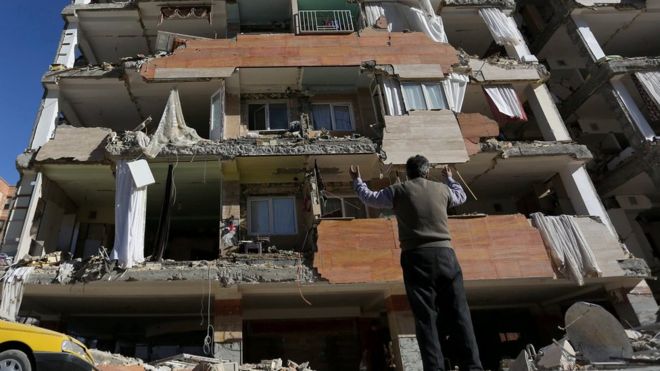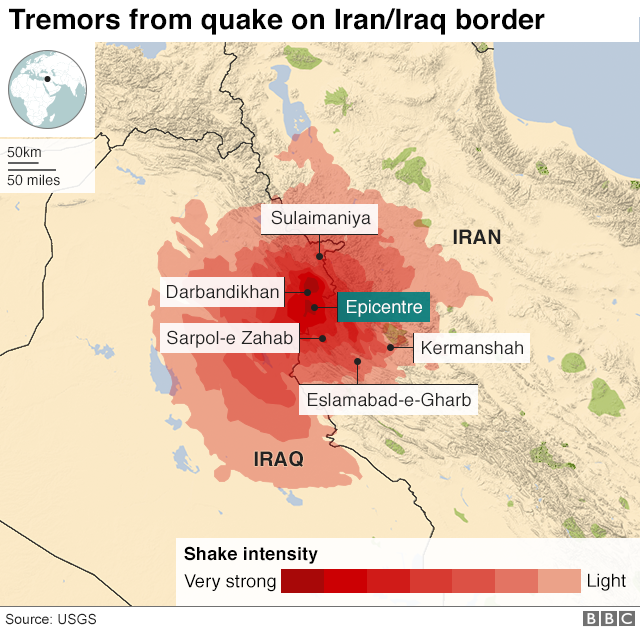Iran-Iraq earthquake: Hundreds killed as border region hit

A man reacts as he looks at a damaged building in Sarpol-e Zahab county in Kermanshah, Iran
Image copyrightREUTERS/TASNIM NEWS AGENCY
Most of the deaths were reported in Iran's Kermanshah province
A 7.3-magnitude earthquake has shaken the northern border region between Iran and Iraq, killing at least 396 people and injuring thousands more.
More than 7,000 people are also said to have been injured in the quake, the world's deadliest this year.
Most of those who died were in Iran's western Kermanshah province, where a search for survivors has started.
Nine more people died in Iraq, where residents fled from their homes into the streets in the capital, Baghdad.
"I was sitting with my kids having dinner and suddenly the building was just dancing in the air," a Baghdad resident, Majida Ameer, told Reuters news agency.
"I thought at first that it was a huge bomb. But then I heard everyone around me screaming: 'Earthquake!'"
In the latest updates from Iran:
- State news agency Irna quoted an emergency official as saying 6,603 people were injured in Iran alone
- Most of the victims were in the town of Sarpol-e Zahab, about 15km (10 miles) from the border, emergency services chief Pir Hossein Koolivand said
- The town's main hospital was severely damaged, leaving it struggling to treat hundreds of wounded, state TV reported
- A woman and her baby were pulled alive from rubble in the town, Iranian media said
- One aid agency said 70,000 people needed shelter after the quake.
Many homes in the predominantly Kurdish mountainous area are made of mud bricks and are vulnerable in quakes as large as Sunday's.

A map showing an earthquake in the Iran-Iraq border region
In Sarpol-e Zahab, a city of about 85,000 people, the sides of a number of tall buildings collapsed, forcing many people to spend the night outdoors in freezing conditions.
Rescue teams were being hampered by landslides, emergency workers said.
The quake hit at 21:18 local time (18:18 GMT) about 30km south-west of Halabja, near the north-eastern border with Iran, the US Geological Survey (USGS) said.
About 1.8 million people live within 100km of the epicentre, the UN estimates.
On the Iraqi side, the most extensive damage was in the town of Darbandikhan in the Kurdistan Region.
"The situation there is very critical," Kurdish Health Minister Rekawt Hama Rasheed told Reuters news agency.
Yaseen Abbas of the Iraqi Red Crescent Society told the BBC that 425 people had been wounded in the Iraqi Kurdistan region, where Turkey has already delivered aid.
The BBC's Rami Ruhayem, in the regional capital Irbil, said shaking there had lasted for more than a minute.
"For a few seconds at first it was barely detectable, I wasn't sure whether it was a minor tremor or just my imagination," he said. "But soon enough it was unmistakable as the building started swaying from side to side."
An Iraqi Kurdish man walks by a large rock which fell from the top of a mountain during the earthquake that hit Darbandikhan townImage copyrightEPA

This huge rock fell from a mountain in Darbandikhan, Iraq
The earthquake struck at a relatively shallow depth of 23.2 km, and tremors were felt in Turkey, Israel and Kuwait.
In 2003, a 6.6-magnitude quake destroyed the historic city of Bam in south-east Iran, killing 26,000 people.
Sunday's quake is the deadliest to hit Iran since 2012. But it is only the sixth earthquake of magnitude-7.0 or more in 2017 - there were 16 last year and 19 the year before.
No comments:
Post a Comment